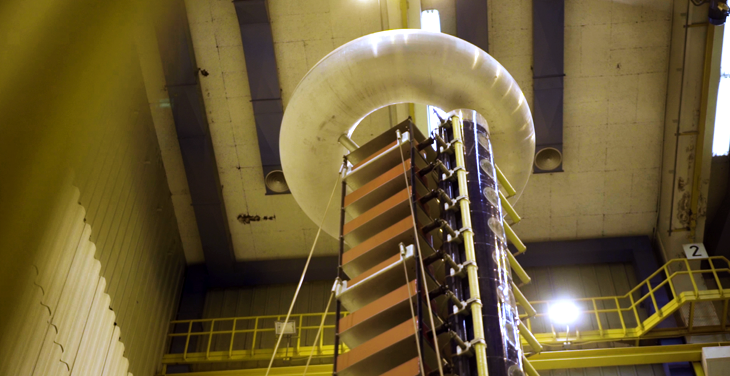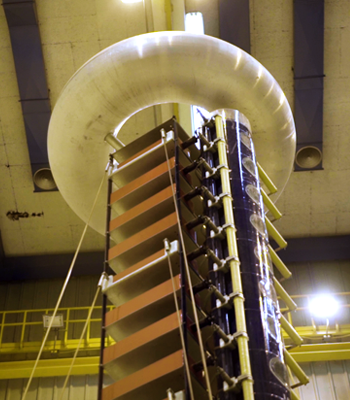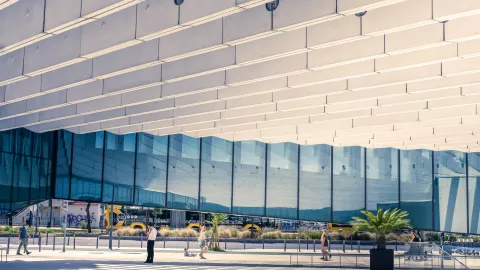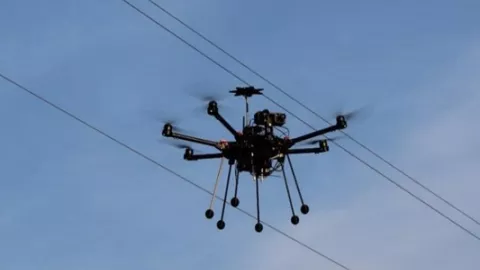An electrical engineer, a marine biologist, and a chemical engineer are at the door of a bar... and in fact they are just enjoying lunch time as they all work at EDP Labelec. The joke is over here, but it is still funny that there are professions so different from the usual ones in EDP facilities. That's why we decided to discover this laboratory, the authentic “family” of Labelec professionals and the innovative projects they are developing.


In a tall building, present in an industrial area outside Lisbon, at Labelec we have the presence of “unlikely” professions. Down the corridors, fresh and naturally lit, professionals in white coats intersect with others dressed informally - the atmosphere is relaxed and friendly, everyone says “good morning” with a smile.
Rui Martins, responsible for the Testing area, one of the four areas of intervention at Labelec, confirms that the good environment is part of the company's DNA.
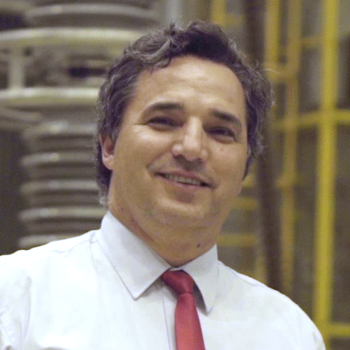
«Our activity is not very individualistic, people are in a laboratory, do teamwork, so in the day to day they end up socializing (because in the background it's a very practical activity) and this results in a good environment, people talking, greeting, and deep down they care about each other.»
Rui Martins, Responsible Person for Testing, Labelec
In addition to being warm, the atmosphere is also very quiet: little more is heard than the occasional door opening or closing. And as we walk down the corridors, we realize that the silence is justified, as most people are outside and doing field work. Dozens of freezers, neatly stacked near several rooms, confirm this: they are used to transport samples collected on site for laboratory analysis.

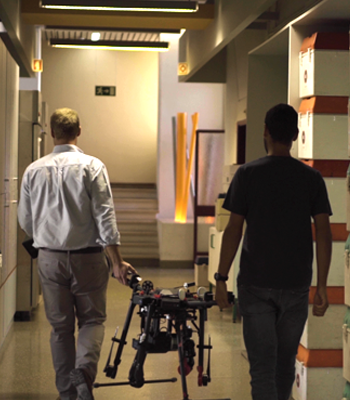
The projects developed at Labelec serve internal (EDP) and external clients, but are generally related, even if indirectly, to the electricity universe.
Dealing with the high voltage
In addition to inspecting power grid assets, for example for EDP Distribuição, EDP Produção, Labelec works closely with other EDP instances in various areas. But when it comes to pure and hard electricity - more specifically, high voltage - the real "action" takes place at the High Voltage Laboratory.
The High Voltage Laboratory. is in an adjoining building. And the correlation with the National Power Grid is obvious: as soon as we step through its doors, we come across a control room that overlooks a gigantic hangar-like space, home to the most varied (and huge) test tools.
Here, one of the goals is to be able to simulate phenomena that occur in nature, such as lightning strikes, rain or fog, to understand how the materials behave and how resistant they are. Rui Martins explains that there arrive, for example, components of electrical substations or large transformers, to be evaluated.
In addition, it is also in this laboratory that all types of working tools in tension, which is mandatory for the EDP Distribution's picket technicians, among others. Testing rubber arc flash protection gloves, for example, involves submerging each glove in water and then subjecting it to high voltage electrical current. If it resists, which means that it did not puncture or show signs of fragility, the equipment will then be certified and can be used by professionals in the field.
Still within the scope of its most electricity-related activities, Labelec has numerous other laboratories, from meter inspection to smart meter testing to transformer testing. And it was precisely in this sector of transformers that we found highly skilled professionals in an unusual knowledge area at EDP: chemical engineering.
The blood of the transformers
Anabela Peixoto is a chemical engineer and has worked at Labelec for almost 30 years in the area of Insulating Materials. She confesses that one of the lab's challenges is “talking to electrical technicians,” as she explains: “our customers are the people in charge of the transformers but we, the doors inside, are chemists, we do chemical analysis”.
And this is really the case: the insulation materials laboratory is dedicated to the analysis of insulating oils, which exist inside the transformers we find throughout the power grid. The transformers are made of iron, copper and paper, immersed in oil with dielectric (ie insulating) characteristics that allow all these materials to interact without shorting out.
A high voltage transformer, by its size, can have tons of insulating oil. Over time, and for a variety of reasons, oil can degrade and lose its dielectric characteristics, which can impair (or even make it impossible) the operation of the transformer. Instead of replacing the oil as it once was (which involved tons of waste and environmental impact), it is now possible to regenerate it by returning it to its physicochemical and dielectric characteristics. And this work is developed at Labelec, in the Insulating Materials department.
The chemical analyses performed on the oil allow, on the one hand, to understand its state of degradation, but also help, on the other hand, to identify problems on the transformer itself.

“This activity bears a close resemblance to blood tests. When we do tests, we want to know how our hemoglobin, our red blood cells are doing… but we essentially want to know how our health is doing, and that is the great function of the transformer insulating oil analyzes. Give us information about the state of the transformers. »
Anabela Peixoto, Chemical Engineer at Labelec, Area Manager, Insulating Materials Department, Testing & Testing
Labelec professionals often work on the ground with machines next to the transformer in question, which can prove to be a real adventure. Anabela recalls an occasion when they had to regenerate the oil from a transformer in an underground substation in central Lisbon, resulting in traffic cuts, police presence and a delicate operation to position the machines on a poorly resistant floor. But in the end "everything ended in beauty", in the words of Anabela, and it is these adventures that bring the most excitement to the activity.
A fish lift
The Touvedo dam fish passage device, located on the Lima river, was built to mitigate the impact that dam construction and exploitation had on some fish species. Like the fish ladders (which you can find here), the lift will allow various species to continue their usual route along the river, particularly for reproductive migrations.
The fish lift consists of a channel, which is downstream of the dam, with three inlets that are fed by a certain traction flow to facilitate the entry of the fish. The animals travel down this canal to a tub - a quadrangular “container” about 0.8 meter by 1m40, similar to a traditional lift. But with the particularity of having a grid drawn, which helps determine the size of the fish that enter there. Every 4 hours, the tank rises to the upstream level, where it releases the animals in a channel that gives access to the reservoir.
In this way, the fish enter on one side of the dam and leave on the other, not being impacted by the large “gap” that separates the river. "It's a relatively similar operation to a lift as we know it," says João Padua. An environmental biologist, he speaks with a slow voice and serious tone about his work at Labelec. But when we realized that the presence of a 50cm salmon in the lift was seen as the “climax” of the project, as he described it, we began to understand the level of passion for the work present here. And João confesses: "More than work, this is what I am. Water is a transverse element in all my personal and professional life, in all its dimensions, so that's what I am."
The drone as a work tool
João Padua's passion for the aquatic environment is comparable to André Coelho's enthusiasm for the air, as this is the main stage of the project to which he is now engaged: the supervision of EDP assets with the help of drones.

"Asset inspection consists of a set of operations that we perform with the equipment of the power grid, to ensure their correct operation and to prioritize the necessary maintenance actions."
André Coelho, Electrical Engineer at Labelec
It is therefore the inspection of the state of the power lines, electrical substations, photo-voltaic modules, wind turbines or even dams, therefore equipment that constitutes assets of the electric grid and EDP.
EDP has been using drones to fly over assets and capture information about their status since around 2015 (and you can know everything about this project here), as until then the same functions were performed aboard a helicopter. One of the advantages of the drone is the lower cost of operation and environmental cost as it uses much less energy than a helicopter. On the other hand, there is also greater safety and lightness in these activities when compared to the inspection done in a much heavier vehicle with much more impact, such as an helicopter.
This was, in fact, one of the issues that concerned the inspection team and which André Coelho recalls, laughing. "We did an inspection in the Azores, in an environment where there were a lot of cows, and because of our experience with the helicopter, this was one of our concerns, because we didn't want to cause any inconvenience to the animals. But the truth is that the cows didn't even notice the drone's presence and we even have a set of drone photographs next to the cows - that is, it turns out to be much less intrusive in how it operates than the helicopter. "

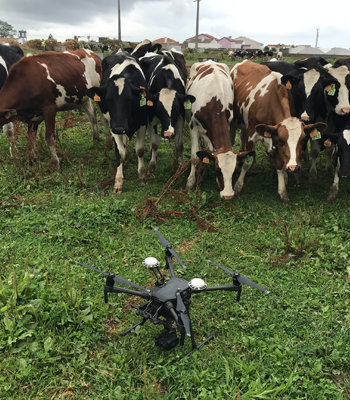
"Here we make innovation!"
Innovation is the watchword and as we pass through FabLab, the EDP Group's innovation factory, as it is called, we realize that. This large room, packed with state-of-the-art gadgets, helps us understand the essence of Labelec: each experience serves to lift the veil on new services and new possibilities. And the team's ingenuity is evident in every creation: from simple parts made with 3D printers, to assembling the first drone used by the asset inspection team.
With around 120 employees in more than 8 separate laboratories, Labelec has been growing at the rate of at least one new laboratory per year. And growth promises not to stop here, with the curiosity and pioneering spirit of professionals as the main catalyst. The limit? This lies only in their imagination, as the Labelec "family" will be responsible for making it a reality.
